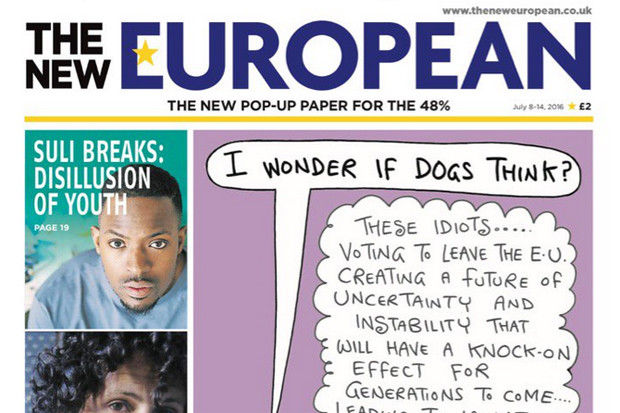“The number one objective for a newspaper is to be talked about,” said Matt Kelly, editor of The New European, speaking at the Digital Media Strategies conference today (22 February).
He explained that the ‘pop-up’ national paper, which went from concept to publication in nine days, owes its success to the strength of the community which it serves – the 48 per cent (16 million) of Britons who voted to remain in the European Union.
“On the day of the result, there was a sense of bereavement, that something awful had just happened – a collective sense of gloom,” he said.
“I thought, what could be the paper that one of the 48 per cent would pick up and carry around to demonstrate that they were part of that very clear, self-defined group of people that suddenly felt disenfranchised?”
The idea is that it costs £2 to join a community and you get a free newspaper every weekMatt Kelly, The New European
The idea that print could be a form of visible anger and sense of community led regional publisher Archant to boldly launch a weekly newspaper on 8 July 2016.
“The idea is that it costs £2 to join a community and you get a free newspaper every week, and that’s very much the sense we’ve got from our audience,” he said. It’s the defined audience that has prevented it from slipping by the wayside like other new publications such as The New Day, which closed just nine weeks after it launched, he added.
And, as Kelly explained, the production team are there for the passion of the cause, with writers seeing it as a good element in a “diminished moment of media plurality”, with many of them contributing for free, writing features as long as 3,000 words.
“Longform journalism is our preferred length, because as we are moving into a society that is so reductive, where word counts are collapsing everywhere, and sophisticated thought is contracted as well.
“We want the audience to have a sense of value with it, that they can read it throughout the week – not just bought in the morning and thrown out in the evening.”
The first edition sold over 40,000 copies, double of what the team at Archant were expecting, and is now selling an average of 25,000 copies a week.
“We still think it is a short-lived product, but the paper keeps growing and changing. We were only supposed to run for four issues,” said Kelly.
If people drift away from it, there’s no problem at all and we will switch it off with incredible alacrityMatt Kelly, The New European
“If it gets to 12,000 copies sold, it’s around break-even, and we would have to start re-thinking things. But if people drift away from it, there’s no problem at all, and we will switch it off with incredible alacrity.”
Kelly explained that although the pop-up model isn’t necessarily sustainable over a long time, the mindset of pop-up publishing is something that the media industry should adopt. Niches in publishing offer perfect opportunities for this format. “The more of these things you do, the more chance you have on stumbling on something great.”
“It makes you less scared about the potential of failure – we set out saying if it doesn’t work we’d kill it after a few weeks.
“The New Day set out the traditional way with a massive plan, marketing campaign and budget. That’s a different state of mind to what we had with The New European. If you’re not fearful of the ’three year plan’, then you can take a chance.”
Free daily newsletter
If you like our news and feature articles, you can sign up to receive our free daily (Mon-Fri) email newsletter (mobile friendly).
Related articles
- Noon founder Eleanor Mills: "Women don't have a sell-by date"
- Tip: Community advisory boards 101
- Independent journalist launches new hyperlocal title to serve London communities
- Fever Pit'ch: a football newsletter powered by reader-first approach and strong community
- How four European publishers experiment with new tools to grow their audience










